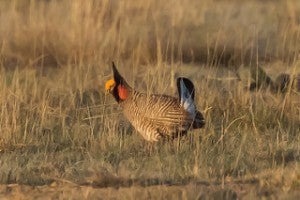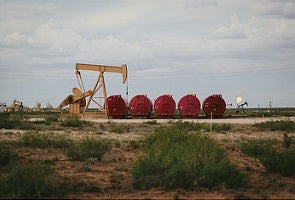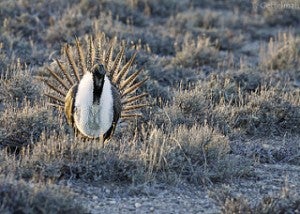
2015 marked the end of a five-year drought, bringing relief to the parched prairie region. But climate impacts like drought and wildfires are only expected to increase in the future, threatening lesser prairie-chicken recovery efforts. Credit: Lesser Prairie Chicken via photopin (license)
Recent media reports have touted population rebounds for the lesser prairie-chicken – up 25 percent from last year. That’s great news for the bird, which was nearly wiped out in recent years as booming oil and gas industries encroached on the bird’s range across Texas, Kansas, Oklahoma, Colorado and New Mexico.
The U.S. Fish and Wildlife Service listed the bird as “threatened” in March 2015, at the same time that the five states embarked on a conservation plan of their own. The plan was officially assembled and endorsed by the five members of the Western Association of Fish and Wildlife Agencies (WAFWA).
Now that bird numbers are up, WAFWA is claiming success – attributing the chicken’s rebound to effective implementation of their Lesser Prairie-Chicken Rangewide Conservation Plan (RWP). Certainly that program has provided some benefit, but the key question is whether the program has been a big enough boost to set the lesser prairie-chicken on a path to recovery.
Improvements needed
WAFWA continues to tout the number of acres enrolled in conservation agreements as evidence of their success. But this number does not correlate to the acreage of land protected or enhanced to benefit lesser prairie-chickens. It is rather the acreage that enrollees in the RWP (industrial developers like oil and gas companies) are likely to impact with development.

Read the latest on WAFWA’s rangewide conservation plan for the lesser prairie-chicken in E&E. Credit: Tanks via photopin (license)
More clarity and detail is needed to understand precisely whether impacts from oil and gas drilling and other industrial infrastructure are being fully mitigated by the RWP.
U.S. Fish and Wildlife Service Director Dan Ashe sent a memo to WAFWA in December raising these transparency and accounting concerns, writing that because WAFWA has still not created a database to track affected land and corresponding mitigation efforts, “the Service is unable to determine that the [rangewide plan] is offsetting the impacts to lesser prairie-chickens.”
A better plan is needed to track both impacts and offsets to lesser prairie-chicken habitat to ensure success over the course of the next several years, when drought and wildfires are likely to return to the landscape.
What should this look like?
For starters, WAFWA should provide rigorous, transparent and quantifiable accounting of both the specific decline of habitat quality driven by energy and industrial development in the landscape, and the specific quantity and quality of offsetting conservation.
It should also take a hard look at integrating other compensatory mitigation approaches like habitat exchanges and conservation banks into its program to ensure that all options are available to landowners seeking to restore and maintain lesser prairie-chicken habitat on their land.
A lesson for the future

EDF has also worked to build habitat exchanges for the greater sage-grouse, the golden-cheeked warbler and other at-risk wildlife.
Full disclosure: EDF has been a proponent of the Lesser Prairie-Chicken Habitat Exchange, a proposal that has taken a back seat to the RWP. But our critique is not just sour grapes. WAFWA is implementing a bold and innovative new model of conservation intended to provide states more control over the recovery of declining species.
If this model is to be replicated, the public has to have the capacity to understand which elements of the plan are delivering quantifiable benefit for the lesser prairie-chicken, and which require adjustments (or adaptive management) to deliver more benefits.
It’s critical that the public understand what proportion of the recent spike in population is due to acts of God (i.e. better weather) and which are due to successful implementation of conservation efforts.
As the feds look more frequently to the states to manage wildlife, it’s imperative that states adopt plans that use the best science, maintain the highest level of transparency, apply rigorous accounting of impacts and improvements, and engage local landowners in ways that incentivize large landscape conservation. That’s the only way that states will be able to guarantee success and protect themselves from years-long court battles that too often delay conservation and waste taxpayers’ money.
Related:
Ranchers and conservationists step up to avert listing of sage-grouse >>
Operation Warbler: Fort Hood and local ranchers team up to save bird >>









